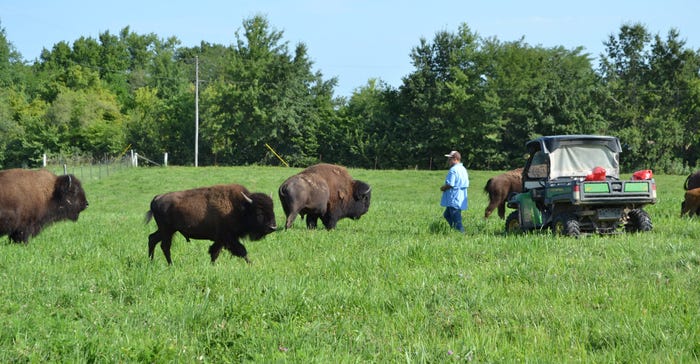August 12, 2022

Growing up on a multispecies livestock family ranch, Marc Schmidt and his brothers raised and showed everything from cattle to sheep and swine. Yet, Schmidt wanted to pursue a new venture and had two species in mind: elk and bison.
Bison don’t require a permit to raise in Missouri, so he took a trip to a livestock auction in the northwest part of the state and came home with two calves — despite some initial hesitation from family members.
“I called my mom to tell her I needed to use the livestock trailer because I’d made a purchase,” Schmidt says. “When I told them it was bison, they thought I was joking. Now, the rest is pretty much history.”
Educational journey
Schmidt’s Bison started with just two calves. Over the past five years, the operation expanded to include one bull, six cows, three yearlings and currently five calves. Schmidt says the process was definitely a learning curve.
“It took a little longer than I thought to get started,” the Monroe County native says. “Bison don’t grow, develop and mature as quickly as other types of livestock.”
Bison are hardier and not as domesticated, so Schmidt says the species tends to stick to their natural tendencies and habits, like grazing in packs. They also have a distinctive laid-back yet stubborn demeanor, and don’t require much management and intervention. Schmidt says he doesn’t need to vaccinate, wean or assist with calving.
Schmidt has grown to appreciate such a minimalistic production approach, as he and his fiancée, Shannon Mitchell, are both full-time teachers in the Moberly School District. This fall is Schmidt’s first year as an agricultural instructor and FFA advisor, after teaching history for several years. Mitchell teaches middle school science.
“Being an educator was a reason I was attracted to bison,” Schmidt says. “As a national mammal, there's a lot of history behind them. For my FFA students, there might be opportunities for hands-on learning.”
Building the business
Earlier this year, Schmidt did a “test run” when the first from his herd was harvested. Some products made from bison are ground meat, roast and steaks (including rib-eyes, T-bones and sirloins).
From Mitchell and Schmidt’s perspective, the flavor is a mixture between beef and deer. In the future, he hopes to eventually offer halves and wholes for consumers to purchase.
Speaking from experience, Schmidt recommends producers start small when wanting to incorporate bison into their operation.
When he first became interested, Schmidt says he visited a few bison operations in southern Missouri, including Back Forty Ranch in Springfield, Mo., to gain some perspective, background knowledge and check out their facilities.
“The way they were able to maneuver their herd throughout the operation was impressive,” he says. “It was easy on the animals and kept them very calm. Looking ahead, we’re hoping to set up a similar fencing system.”
Despite the recent resurfacing of bison farms throughout the U.S., Schmidt says there aren’t many in his area. According to the Missouri Department of Conservation, a small herd of about 100 bison live at Prairie State Park in Barton County. Others live on private ranches. The Missouri Bison Association estimates about 2,000 bison on 50 ranches across the state.
The couple plans to continue learning as much as they can and grow their herd, but they want to remain fairly small-scale with about 20 breeding head total.
True to their educational backgrounds, the couple enjoy sharing the history of bison and their production practices.
“Most people think bison are wild animals, but we can walk up and feed them by hand,” Schmidt says. “They’re pretty friendly and self-sufficient. I’ve come to realize if you give them their space, you don’t have to worry too much — unless you leave the gate open!”
You can follow the couple’s bison journey on Facebook at Schmidt’s Bison.
Quinlan writes from Mexico, Mo.
You May Also Like




